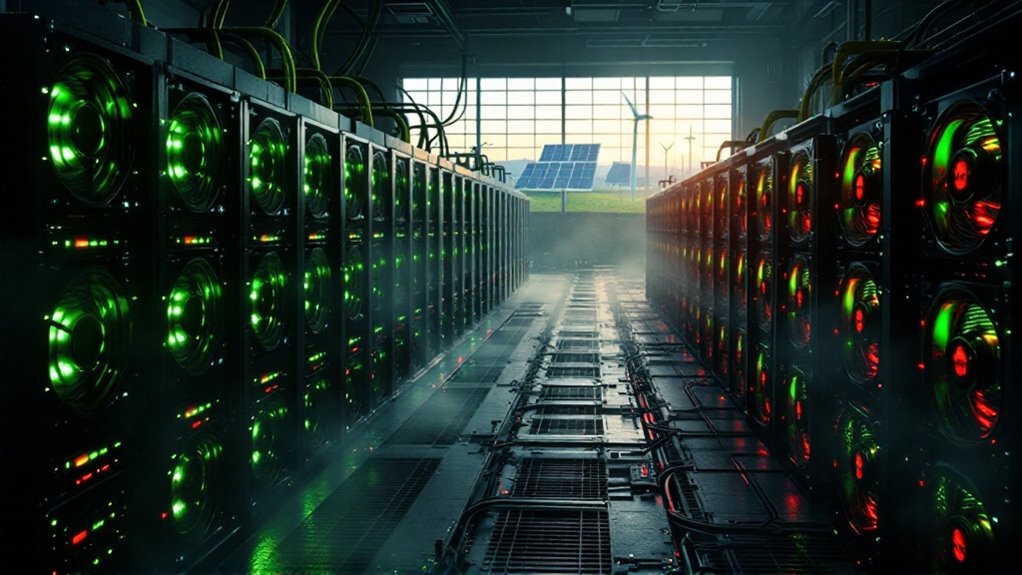Cryptocurrency mining profitability hinges on a delicate balance of factors, much like a high-stakes digital gold rush. Hardware choices, particularly ASIC machines and graphics cards, must align with ever-changing market conditions and electricity costs. While mining pools offer steady returns, solo mining presents riskier but potentially larger rewards. Government regulations and emerging proof-of-stake systems continue reshaping the landscape. Success requires careful planning, adaptability, and a deep understanding of this evolving digital frontier.

The labyrinth of cryptocurrency mining profitability winds through a complex maze of ever-shifting variables. Like prospectors in a digital gold rush, miners must navigate a landscape where cryptocurrency prices dance unpredictably, network difficulties adjust relentlessly, and block rewards shrink with each halving cycle. The siren song of potential profits echoes through server rooms worldwide, but success requires a delicate balance of multiple factors working in harmony.
Hardware selection stands as the first essential crossroad for aspiring miners. ASIC machines hum efficiently for Bitcoin mining, while graphics cards flash and whir for altcoin extraction. Each piece of equipment tells its own story through measurements like joules per terahash, with newer models constantly pushing the boundaries of what's possible. Yet these digital pickaxes come with hefty price tags, and yesterday's cutting-edge machine often becomes tomorrow's paperweight. The rise of mobile mining apps has introduced new, albeit less efficient, options for small-scale participants. Traditional SHA-256 mining has become increasingly competitive, pushing most individual miners toward specialized hardware.
Mining hardware choices shape digital destinies, as today's powerful machines inevitably fade into technological relics of a bygone crypto era.
The steady drip of electricity costs forms the heartbeat of mining operations. Some miners chase the dream of cheap power to distant lands, while others harness the sun and wind to feed their hungry rigs. The math is unforgiving – every watt consumed must be justified by the coins produced. Cooling fans spin endlessly, adding their own chorus to the power consumption symphony. The advent of proof-of-work puzzles has made energy efficiency a crucial factor in mining success.
Mining pools offer shelter from the storm of variance, though they take their cut of the rewards. Solo miners play a high-stakes game of chance, waiting for that one lucky block that makes it all worthwhile. The choice between consistent small wins and rare large payouts reveals much about a miner's appetite for risk.
In this evolving landscape, governments cast long shadows with regulations and taxes, while innovative alternatives like cloud mining and proof-of-stake systems emerge from the digital mist. Online calculators attempt to pierce the fog of uncertainty, but their predictions dance like leaves in the wind as market conditions shift.
For those who dare to mine, success requires constant adaptation, careful planning, and perhaps a touch of digital alchemy to transform electricity into profit.
Frequently Asked Questions
How Long Does It Take for Mining Equipment to Become Obsolete?
Mining equipment typically becomes obsolete within 3-5 years due to advancing technology, increasing mining difficulty, and efficiency requirements. However, actual lifespan varies based on maintenance, operating conditions, and market dynamics.
What Happens to Mining Profits During Cryptocurrency Market Crashes?
During cryptocurrency market crashes, mining profits decline sharply as coin values drop. Revenue falls greatly, smaller operations shut down, and only large miners with low electricity costs typically remain profitable and operational.
Can I Mine Different Cryptocurrencies With the Same Hardware Setup?
Most mining hardware can switch between compatible cryptocurrencies. GPU rigs offer versatility for multiple coins, while ASIC miners are algorithm-specific. Software solutions enable efficient switching to maximize profitability across different cryptocurrencies.
Which Cryptocurrencies Are the Most Profitable to Mine for Beginners?
For beginners, Monero and Ravencoin offer good mining potential with standard computer hardware. Bitcoin requires expensive ASIC equipment, while Dogecoin and Litecoin present moderate difficulty levels with reasonable profit opportunities.
How Does Seasonal Electricity Pricing Affect Mining Profitability Calculations?
Seasonal electricity rates greatly impact profitability calculations. Higher summer prices reduce margins, while lower winter rates increase profits. Miners must account for these fluctuations when calculating annual operational costs and expected returns.









